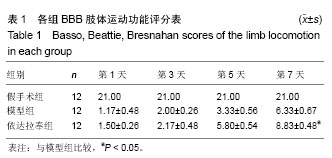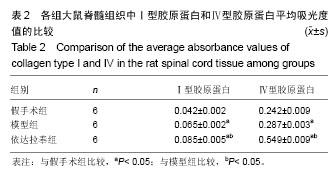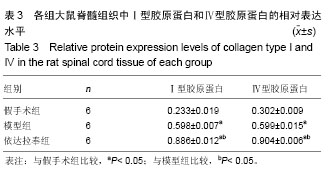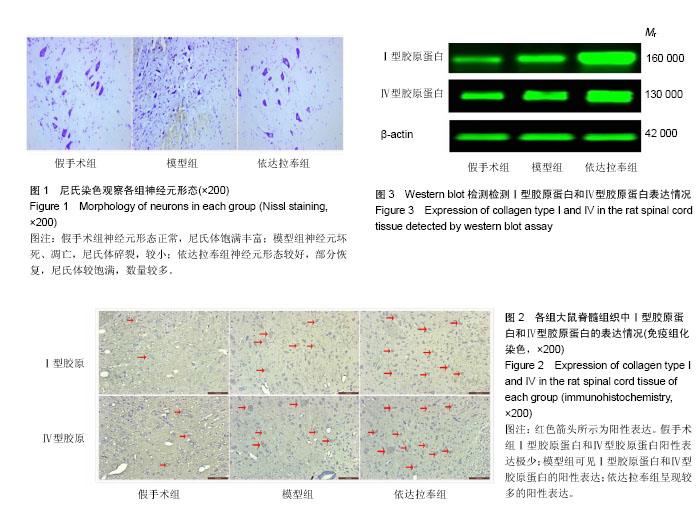| [1] Wenta C, Lin HC, Lam C, et al.Epidemiology of traumatic spinal cord injury: comparisons between developed and developing countries .Asia Pac J Public Health.2010;22(1): 9-18.[2] 刘明永,赵建华,王爱民.脊髓损伤的细胞疗法进展[J].创伤外科杂志,2010,12(2):186-189.[3] 杨成林,查雪峰.中西医结合治疗急性脊椎损伤的临床研究[J].中华中医药学刊, 2015,12: 3043-3046.[4] 曾智谋,张寿,刘亦恒.脊髓损伤的病理生理及治疗进展[J].海南医学, 2013, 24(14): 2105-2108.[5] Ren HZ, Zhang XS, Wang LX. Effect of coronary revascularization on serum collagen biomarkers and left ventricular remodeling in patients with acute myocardial infarction.Heart Lung.2012; 41(4):344-349.[6] Hsu JYC, Mckeon R, Goussev S, et al. Matrix Metalloproteinase-2 facilitates wound healing events that promote functional recovery after spinal cord iInjury.J Neurosci. 2006;26(39):9841-9850.[7] Mao M, Alavi MV, Cassandre LD, et al. Type IV collagens and basement membrane diseases: cell biology and pathogenic mechanisms. Curr Top Membr.2015;76:61-116.[8] 郭文荣,李兴.糖尿病肾病与ADPN、TGF-β1、Collagen IV、ICAM-1关系的研究进展[J].医学研究杂志,2015,44(6):170-173.[9] Anik I, Kokturk S, Genc H, et al. Immunohistochemical analysis of TIMP-2 and collagen types I and IV in experimental spinal cord ischemia-reperfusion injury in rats.J Spinal Cord Med. 2011;34(3):257-264.[10] ]Tanaka M. Pharmacological and clinical prof'de of the free radical scavengeredaravone as a neuroprotective agent. Nippon Yakurigaku Zasshi. 2002;119(5):301-308.[11] Yasuoka N, Nakajima W. Ishida A Neuroprotection of edaravone on hypoxic-ischemic brain injury in neonatal rats. Brain Res Dev Brain Res.2004;151(1-2):129-139.[12] Takahashi G, Sakurai M, Abe K, et al. MCI-186 reduces oxidative cellular damage and increases DNA repair function in the rabbit spinal cord after transient ischemia. Ann Thorac Surg. 2004;78(2):602-607.[13] Qi W, Niu J, Qin Q, et al. Glycated albumin triggers fibrosis and apoptosis via an NADPH oxidase/Nox4-MAPK pathway-dependent mechanism in renal proximal tubular cells.Endocrinology.2015;40(5):74-83.[14] GorinY,BlockK,HernandezJ,et al. Nox4 NAD(P)H oxidase mediateshypertrophy and fibronectin expression in the diabetic kidney. J Biol Chem. 2005;280(47):3616-3626. [15] Sedeek M, Callera G,Montezano A, et al. Critical role of Nox4-based NADPH oxidase in glucose-induced oxidative stress in the kidney-implications in type 2 diabetic nephropathy. Am J Physiol Renal Physiol. 2010;299(6): 1348-1358. [16] Chen WF, Chen CH, Chen NF, et al. Neuroprotectiveeffects of direct intrathecaladministration of granulocyte colony-stimulatingfactor inrats with spinal cord injury. CNS Drugs. 2015;21(9):698-707.[17] Xiong Y, Rabchevsky AG, Hall ED. Role of peroxynitrite in secondary oxidative damage after spinal cord injury.J Neurochem. 2007;100(3):639-649.[18] Bareyre F M. Neuronal repair and replacement in spinal cord injury. J Neurol Sci. 2008;265(1):63-72.[19] Nigam S, Schewe T. Phospholipase A(2)s and lipid peroxidation.BiochimBiophysActa. 2000;1488(1):167-181.[20] 卢育南,许逸洋,曾奕,等.二甲亚砜对脊髓损伤的抗自由基保护作用[J].解剖学研究, 2012, 34(1):16-20.[21] Tator CH, Koyanagi I. Vascular mechanisms in the pathophysiology of human spinal cord injury. Neurosurg. 1997;86(3): 483-492.[22] Akdemir H, Pasaoglu A. Histopathology of experimental spinal cord truma. Comparison of treatment with TRH, naloxone, and dexamethasone. Res ExpMed(Berl). 1992; 192(3):177-183.[23] Bullock R, Fujisawa H. The role of gultamata antagonists for the treatment of CNS injury. Neurotrauma.1992;9(Suppl 2): 443-446.[24] Pernet V, Schwab ME. The role of Nogo-A in axonal plasticity,regrowth and repair . Cell Tissue Res.2012;349(1): 97-104.[25] Yuan YM, He C.The glial scar in spinal cord injury and repair.Neurosci Bull.2013;29(4):421-435.[26] 何创. Caveolin-1 对内毒素性肺损伤TGF-β1/Smads信号通路的调控[D].广州中医药大学,2012.[27] Masahiko J, Tanaka B.Pharmacological and clinical profile of the free radical scavenger edaravone as a neuroprotectiveagent. Bull Med Libr Assoc. 2002;119(5): 301-308.[28] Hamaishi M, Orihashi K, IsakaM, et al. Low-dose edaravoneinjection into the clamped aorta prevents ischemic spinal cord injury.Ann Vasc Surg.2009;23(1):128-135.[29] 陈继革,吴华.依达拉奉促进大鼠脊髓损伤神经功能恢复作用研究[J].医药导报, 2007, 26(2):147-148.[30] Sweeney SM, Dilullo G, Slater SJ, et al. Angiogenesis in collagen I requires alpha2beta1 ligation of a GFP*GER sequence and possibly p38 MAPK activation and focal adhesion disassembly.J Biol Chem. 2003;278(33): 30516-30524.[31] Verrecchia F, Mauviel A. TGF-beta and TNF-alpha: antagonistic cytokines controlling type I collagen gene expression. Mol Cell Biol. 2004;16(8):873-880. |
.jpg) 文题释义:
依达拉奉:是一种脑保护剂(自由基清除剂)。临床前研究提示,大鼠在缺血/缺血再灌注后静脉给予依达拉奉,可阻止脑水肿和脑梗死的进展,并缓解所伴随的神经症状,抑制迟发性神经元死亡。机制研究提示,依达拉奉可清除自由基,抑制脂质过氧化,从而抑制脑细胞、血管内皮细胞、神经细胞的氧化损伤。
脊髓功能Basso,Beattie,Bresnahan(BBB)评分:常用的运动功能评分法,此法几乎包括了脊髓损伤后运动功能恢复过程中所有行为变化,且与脊髓损伤的程度高度相符,又无需特殊设备,但标准较复杂,需对观察人员进行一定的训练,以减少主观因素的影响。操作方法是将动物放入开口盆,轻敲盆壁,使其爬行,观察动物的臀、膝、踝关节行走、躯干运动及其协调情况。总分21分。
文题释义:
依达拉奉:是一种脑保护剂(自由基清除剂)。临床前研究提示,大鼠在缺血/缺血再灌注后静脉给予依达拉奉,可阻止脑水肿和脑梗死的进展,并缓解所伴随的神经症状,抑制迟发性神经元死亡。机制研究提示,依达拉奉可清除自由基,抑制脂质过氧化,从而抑制脑细胞、血管内皮细胞、神经细胞的氧化损伤。
脊髓功能Basso,Beattie,Bresnahan(BBB)评分:常用的运动功能评分法,此法几乎包括了脊髓损伤后运动功能恢复过程中所有行为变化,且与脊髓损伤的程度高度相符,又无需特殊设备,但标准较复杂,需对观察人员进行一定的训练,以减少主观因素的影响。操作方法是将动物放入开口盆,轻敲盆壁,使其爬行,观察动物的臀、膝、踝关节行走、躯干运动及其协调情况。总分21分。.jpg) 文题释义:
依达拉奉:是一种脑保护剂(自由基清除剂)。临床前研究提示,大鼠在缺血/缺血再灌注后静脉给予依达拉奉,可阻止脑水肿和脑梗死的进展,并缓解所伴随的神经症状,抑制迟发性神经元死亡。机制研究提示,依达拉奉可清除自由基,抑制脂质过氧化,从而抑制脑细胞、血管内皮细胞、神经细胞的氧化损伤。
脊髓功能Basso,Beattie,Bresnahan(BBB)评分:常用的运动功能评分法,此法几乎包括了脊髓损伤后运动功能恢复过程中所有行为变化,且与脊髓损伤的程度高度相符,又无需特殊设备,但标准较复杂,需对观察人员进行一定的训练,以减少主观因素的影响。操作方法是将动物放入开口盆,轻敲盆壁,使其爬行,观察动物的臀、膝、踝关节行走、躯干运动及其协调情况。总分21分。
文题释义:
依达拉奉:是一种脑保护剂(自由基清除剂)。临床前研究提示,大鼠在缺血/缺血再灌注后静脉给予依达拉奉,可阻止脑水肿和脑梗死的进展,并缓解所伴随的神经症状,抑制迟发性神经元死亡。机制研究提示,依达拉奉可清除自由基,抑制脂质过氧化,从而抑制脑细胞、血管内皮细胞、神经细胞的氧化损伤。
脊髓功能Basso,Beattie,Bresnahan(BBB)评分:常用的运动功能评分法,此法几乎包括了脊髓损伤后运动功能恢复过程中所有行为变化,且与脊髓损伤的程度高度相符,又无需特殊设备,但标准较复杂,需对观察人员进行一定的训练,以减少主观因素的影响。操作方法是将动物放入开口盆,轻敲盆壁,使其爬行,观察动物的臀、膝、踝关节行走、躯干运动及其协调情况。总分21分。



.jpg) 文题释义:
依达拉奉:是一种脑保护剂(自由基清除剂)。临床前研究提示,大鼠在缺血/缺血再灌注后静脉给予依达拉奉,可阻止脑水肿和脑梗死的进展,并缓解所伴随的神经症状,抑制迟发性神经元死亡。机制研究提示,依达拉奉可清除自由基,抑制脂质过氧化,从而抑制脑细胞、血管内皮细胞、神经细胞的氧化损伤。
脊髓功能Basso,Beattie,Bresnahan(BBB)评分:常用的运动功能评分法,此法几乎包括了脊髓损伤后运动功能恢复过程中所有行为变化,且与脊髓损伤的程度高度相符,又无需特殊设备,但标准较复杂,需对观察人员进行一定的训练,以减少主观因素的影响。操作方法是将动物放入开口盆,轻敲盆壁,使其爬行,观察动物的臀、膝、踝关节行走、躯干运动及其协调情况。总分21分。
文题释义:
依达拉奉:是一种脑保护剂(自由基清除剂)。临床前研究提示,大鼠在缺血/缺血再灌注后静脉给予依达拉奉,可阻止脑水肿和脑梗死的进展,并缓解所伴随的神经症状,抑制迟发性神经元死亡。机制研究提示,依达拉奉可清除自由基,抑制脂质过氧化,从而抑制脑细胞、血管内皮细胞、神经细胞的氧化损伤。
脊髓功能Basso,Beattie,Bresnahan(BBB)评分:常用的运动功能评分法,此法几乎包括了脊髓损伤后运动功能恢复过程中所有行为变化,且与脊髓损伤的程度高度相符,又无需特殊设备,但标准较复杂,需对观察人员进行一定的训练,以减少主观因素的影响。操作方法是将动物放入开口盆,轻敲盆壁,使其爬行,观察动物的臀、膝、踝关节行走、躯干运动及其协调情况。总分21分。